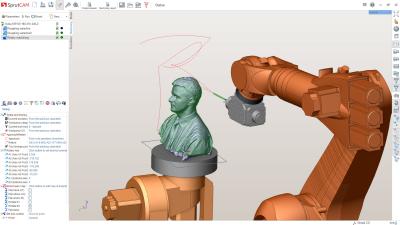
SprutCAM America has announced the release of SprutCAM 12, the company’s latest CAM software. The new software is now live on the company’s website (www.sprutcamamerica.com).
SprutCAM 12 features numerous upgrades including:
- A new, more user-friendly interface
- New, 2D CAD editor integrated into the model page
- Product and Manufacturing Information (PMI) Import
- Innovative Adaptive SC High-Speed Machining Operation
- Painting Simulation
- 5-Axis Tool Path Conversion
The company’s popular SprutCAM12 Robot version, which is a single environment for the offline programming of industrial robots, is now available for a one-time cost of $9,995, which allows milling with a robotic arm. Other features are available through an optional module which includes cladding, plasma, jet cutting, welding and sawing.
The cost for yearly maintenance of that module is $1,850. SprutCAM Robot supports programming of many types of industrial robots, including FANUC, Kuka, Staubli, Yaskawa Motoman, Toshiba, Mitsubishi, Nachi and ABB.
“We are excited about the latest release of SprutCAM 12,” said Jake Stueber, CAD/CAM product specialist at SprutCAM America. “This software is very powerful and is priced significantly less than our competitor’s products. We feel it provides best-in-class performance at best-in-class price.”
Current users of SprutCAM 11 who are on the company’s maintenance plan qualify for a free upgrade to SprutCAM 12.
Contact Details
Related Glossary Terms
- computer-aided design ( CAD)
computer-aided design ( CAD)
Product-design functions performed with the help of computers and special software.
- computer-aided manufacturing ( CAM)
computer-aided manufacturing ( CAM)
Use of computers to control machining and manufacturing processes.
- gang cutting ( milling)
gang cutting ( milling)
Machining with several cutters mounted on a single arbor, generally for simultaneous cutting.
- milling
milling
Machining operation in which metal or other material is removed by applying power to a rotating cutter. In vertical milling, the cutting tool is mounted vertically on the spindle. In horizontal milling, the cutting tool is mounted horizontally, either directly on the spindle or on an arbor. Horizontal milling is further broken down into conventional milling, where the cutter rotates opposite the direction of feed, or “up” into the workpiece; and climb milling, where the cutter rotates in the direction of feed, or “down” into the workpiece. Milling operations include plane or surface milling, endmilling, facemilling, angle milling, form milling and profiling.
- sawing
sawing
Machining operation in which a powered machine, usually equipped with a blade having milled or ground teeth, is used to part material (cutoff) or give it a new shape (contour bandsawing, band machining). Four basic types of sawing operations are: hacksawing (power or manual operation in which the blade moves back and forth through the work, cutting on one of the strokes); cold or circular sawing (a rotating, circular, toothed blade parts the material much as a workshop table saw or radial-arm saw cuts wood); bandsawing (a flexible, toothed blade rides on wheels under tension and is guided through the work); and abrasive sawing (abrasive points attached to a fiber or metal backing part stock, could be considered a grinding operation).
